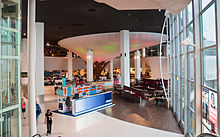Auckland Airport
The airport has a single 3,535 m (11,598 ft) runway, 05R/23L, which is Cat IIIb capable (at a reduced rate of movements) in the 23L direction.The club president noted at the time that the site "has many advantages of vital importance for an aerodrome and training ground.[11] This was chosen, despite the hills adjacent to Whenuapai limiting the ability of newer aircraft to use the facilities, to the lack of cost to the Auckland City Council, as the site was already established as an RNZAF base.[11] In 1958, the New Zealand Government commissioned Leigh Fisher Associates to survey and design the international airport at Māngere.Initially the new runway would have been 1,200-metre (3,900 ft) long and catered for regional flights operated by Air New Zealand using turboprop aircraft.This would have cost $32 million and would have improved the efficiency of the airport by removing smaller planes (which require longer separation distances from the air turbulence wakes of preceding jet airliners) from the main runway.At a later stage, the runway would have been lengthened to 1,950 metres (6,400 ft) to allow it be used by small jets (such as the Boeing 737 and Airbus A320) on domestic and trans-Tasman flights.[21] The ten-year project would cost NZ$120 million, not including substantial extensions planned for the airport arrivals/departure buildings and associated structures.[27] In the second half of 2013, the baggage claim belts were lengthened, parts of the apron was changed, and new corridors were connected to the jetbridges.[33][34] In 1993, the CAA instituted the requirement that all international airports in New Zealand must keep airside departing and arriving passengers separate.Following the September 11, 2001 attacks and further regulation by the ICAO, the CAA required the airport to physically separate arriving and departing passengers by 2006.The modifications to the terminal were completed in December 2005,[36] and also involved the expansion of retail space within the pier by 600 square metres (6,500 sq ft) and an increase in the number of bus gates to four.The Jetstar check-in area is located in the western end of the terminal, in the building previously used by Ansett New Zealand, Qantas, and Pacific Blue.[102] As at 31 December 2015, Auckland Airport was the biggest listed company on the NZX, with a market capitalisation of $6.85 Billion NZD.[103] AIAL enjoys diverse revenue streams, and operates a 'dual-till' approach, whereby its finances are split into aeronautical and non-aeronautical balance sheets.Due to the airport having little-to-no competition, the aeronautical side of the business is subject to information disclosure requirements as set by the Commerce Commission.[citation needed] The airport has been criticised by airlines, led by Air New Zealand, for its purportedly high landing charges.The diversity in revenue was of benefit during the downturn in international aviation following the events of 11 September 2001, and subsequently the 2002 Bali bombings, SARS outbreak and the Iraq War.The airport was able to rely on steady income from the non-aeronautical side of the business, which softened the blow of international events.The company has in the past reportedly been singled out by airline lobby group IATA for its consistent excessive level of profits.[105] On 5 June 2007, the airport's 60 per cent profit margin was criticised by IATA director general and CEO Giovanni Bisignani.[107] In 2012, Auckland Airport envisaged to cut the international passenger fee and hike the domestic travellers charges in FY-2013.[112] The 1476 frequency was leased to Independent Broadcasting Company in 1993, which used it at various times for Auckland 1476, The Breeze on 91, Lifestyle Radio, and Today 99.8FM.[111] It was leased to talkback station The Point 1XD in 1994, and made available to Auckland Radio Trust to rebroadcast the BBC World Service in 1998.The preferred option between 2016 and 2024[117] was an entirely new light rail line running from the airport to central Auckland via a direct alignment through Mangere, Onehunga and Mount Roskill.At Mount Roskill, it would have connected to the planned Dominion Road light rail line[118] which would have continued on to Queen Street in Central Auckland before reaching a final terminus in the Wynyard Quarter waterfront development area.






AucklandMāngereNew ZealandAir New ZealandFocus cityQantasAir ChathamsBarrier AirJetstarTime zoneCoordinatesRunwaysConcreteinternational airportbusiest airport in the countrycity centreAirbus A380ChristchurchCat IIIbhectaresDe Havilland Gypsy MothsMangere AerodromeRNZAF Base AucklandWhenuapaiAuckland City CouncilPakurangaNew Zealand GovernmentreclaimedManukau HarbourSydneyBoeing 747Jean Battenturbopropair turbulence wakesBoeing 737Airbus A320EmiratesSingapore AirlinesjetbridgesairsideMāorikarangaSeptember 11, 2001 attacksAnsett New ZealandPacific BluejetbridgeAir CanadaVancouverChatham IslandsKapiti CoastNorfolk IslandWhākataneWhanganuiAir ChinaBeijing–CapitalAdelaideBlenheimBrisbaneDenpasarDunedinGisborneGold CoastHong KongHonoluluHouston–IntercontinentalInvercargillKerikeriLos AngelesMelbourneNapierNelsonNew PlymouthNew York–JFKNouméaNuku'alofaPalmerston NorthPapeeteQueenstownRarotongaRotoruaSan FranciscoShanghai–PudongSingaporeTaipei–TaoyuanTaupōTaurangaTokyo–NaritaWellingtonWhangāreiCairnsHobartSeoul–IncheonSunshine CoastAir Tahiti NuiAircalinAmerican AirlinesDallas/Fort WorthClarisKaitaiaWhitiangaCathay PacificChina AirlinesChina Eastern AirlinesHangzhouChina Southern AirlinesGuangzhouDelta Air LinesDubai–InternationalFiji AirwaysHainan AirlinesHaikouShenzhenHawaiian AirlinesKorean AirLATAM ChileSantiago de ChileMalaysia AirlinesKuala Lumpur–InternationalQatar AirwaysSichuan AirlinesChengdu–TianfuSolomon AirlinesPort VilaUnited AirlinesAirworkAtlas Air